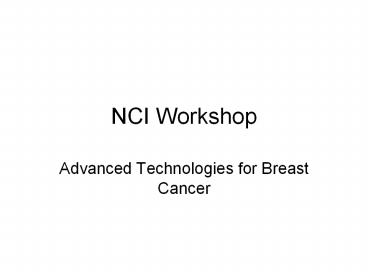NCI Workshop - PowerPoint PPT Presentation
Title:
NCI Workshop
Description:
NCI Workshop Advanced Technologies for Breast Cancer Radiation of Intact Breast Excellent LOCAL CONTROL (95 % at 5 years) achieved with standard dose 50 Gy Whole ... – PowerPoint PPT presentation
Number of Views:29
Avg rating:3.0/5.0
Title: NCI Workshop
1
NCI Workshop
- Advanced Technologies for Breast Cancer
2
Radiation of Intact Breast
- Excellent LOCAL CONTROL (95 at 5 years)
achieved with standard dose 50 Gy Whole Breast
plus boost to primary site - NO NEED to Dose Escalate
- OARs Skin, Lung, Heart (Left sided cases) and
Cosmetic Outcome
3
Intact Breast Phase III Trial
- Vancouver/Toronto Study comparing IMRT to
Standard Wedge 2 D Planning - Presented at ASTRO 2006
- 358 patients entered/331 analyzed for acute
toxicity up to 6 weeks - Results IMRT plans showed improved dose
homogeneity and clinically associated with
reduced incidence moist desquamation (31 vs 48,
p0.0019)
4
Prone IMRT at MSKCC
- Minimize radiation to the heart and lungs by
utilizing gravity effect on mobile breast - Specify beam direction (Two tangent fields)
before inverse planning process to avoid an
increase in integral dose - Bring dose intensity pattern to field edge to
account for minimal edema thru treatment
5
Figure 1a. Customized prone breast board with
adjustable aperture and wedge for contralateral
breast.Figure 1b. Ipsilateral breast and
anterior chest wall hang in a dependent fashion
away from the thorax while the ipsilateral arm is
placed above the head
Goodman
1a
1b
6
Figure 6. Left breast irradiation using prone
breast IMRT technique can spare left ventricle
and coronary arteries.
Goodman
7
Goodman
Figure 4a. Transverse Dose Distributions
IMRT
Conventional
Isodose in
113
108
100
90
50
102
10
8
Goodman
Figure 4b. Sagittal Dose Distributions
Conventional
IMRT
Isodose in
117
108
100
90
50
102
10
9
Figures 3a and 3b. Dose-Volume Histogram (DVH)
for prone breast IMRT technique
Goodman
IMRT
IMRT
CONV
CONV
Fig 3a. 5mm skin was excluded from the PTV. IMRT
Intensity modulated radiation therapy CONV
Conventional tangents
Fig. 3b. Buildup region was included in the
PTV. IMRT Intensity modulated radiation
therapy CONV Conventional tangents
10
Figure 5. Maximum Dose as a Function of Breast
Depth for Simplified IMRT and Conventional
Tangent Plans.
Goodman
11
(No Transcript)
12
Intensity Map of a Typical Breast IMRT Field
depressed intensity through the lung volume
wedge-like intensity distribution
skin flash
13
Breast IMRT at MSKCC
- Viewed (based on prostate model) as an improved
method of dose delivery to primary - Therefore change in technology simply executed in
the department
14
Integrated Boost
- Freedman et al (Fox Chase) have demonstrated
feasibility of doing concomitant boost during
whole breast IMRT with Dose Painting - This is under consideration has an RTOG Phase II
trial
15
Partial Breast RT
- RTOG/NSABP Phase III Trial open since 2005 to
compare Standard Whole Breast RT to Partial
Breast RT using 10 fx in 5 days - Accrual well past 2000 of 3000 planned
- In women randomized to PBI, over 70 are
receiving RT by 3D XRT, 20 by MammoSite and 5
by Brachy
16
MGH PBI/Protons
- 20 Stage I patients in Phase I/II Trial
- Results (Median F/U 12 months) No local failures
- Side Effects Moderate to severe skin color
changes in 79 , moderate to severe moist
desquamation in 22 , skin telangiectasia in 3
patients and rib tenderness in 3 patients
17
(No Transcript)
18
(No Transcript)
19
Post-Mastectomy RT/1
- If breast reconstruction present, similar issues
to intact breast - Chest wall Multiple techniques, including
tangent fields, electron beam, and combinations. - SKIN is part of the target, so skin-sparing not
an advantage
20
Post Mastectomy RT/2
- Supraclavicular Nodal RT always given
- Internal Mammary Nodal RT highly controversial in
standard adjuvant settings (NCCN guidelines Level
3) - OAR include lung, heart, brachial plexus and
esophagus, depending on technique
21
Post Mastectomy RT/3
- NCI-funded Phase III trial now ongoing at U. of
Michigan - Will compare IMRT to 3D Conformal in the
post-mastectomy setting, including regional nodes - No IMRT used off study in this clinical situation
- PI Lori Pierce
22
Hypothetic Plan IMRT/Protons
- Lomax et al at PSI
- Target included breast, and regional nodes
including IMN chain - IMRT plan had increased target homogeneity
compared to 2D, but with increased dose to
critical neighboring organs - 2 field, energy modulated Proton plan appeared
superior to IMRT
23
Other Clinical Scenarios
- Inoperable presentations
- Bulky, non-resectable recurrent cancer
- IMRT plans have sometimes looked significantly
better than 3D conformal, on a CASE BY CASE basis
24
Conclusions/Breast
- One Phase III trial demonstrates superiority of
IMRT over standard treatment, for acute side
effects in the intact breast - Modest decrease in late cardiac and lung toxicity
likely with IMRT (With 2 field tx) - Improvement in local control unlikely, since it
is already at 95 at 5 years
25
More Conclusions
- Limited single institution center studies on IMRT
and Proton use for PBI - Imaging the PTV daily likely needed, given the
tight margins, daily set-up error, organ
deformation (edema) and target mobility with
breathing































